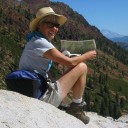John Day Fossil Beds National Monument—stratigraphy
The John Day Fossil Beds is located in north-central Oregon. It was established as a national monument in 1974. The region has one of the world's most complete records of fossils during the Age of Mammals, a period of time also known as the Cenozoic Era (past 66 million years). There will be three blog posts: (1) stratigraphy—how layers of...
Dinosaur National Monument—more public lands worth preserving
My last four posts have been about our public spaces—two national parks and two national monuments. With increased petroleum and mineral exploration and drilling in and near our preserved lands, it behooves us to learn more about the places that may be threatened by the current U.S. administration. In June we visited Dinosaur National Monument, an out-of the way park...
The Great American Biotic Interchange
With its many excellent fossil sites, Argentina has lots of evidence for how life evolved through time. One of the largest effects on how organisms evolved was the position of the continents. For example, when the continents were united into the "super continent" called Pangea at the end of the Paleozoic, land animals could migrate for huge distances. In contrast,...
Argentina—a paradise for fossils of dinosaurs and proto-mammals
We visited Parque (park) Ischigualasto, which means "the place animals go to die" in the local indigenous language. The native people saw many bones in the region, which was the reason for this name. Later, of course, these bones were recognized as animals that have long been extinct. We also visited the Museo de Ciencias Naturales (museum of natural sciences)...
Fossils fossils everywhere (and Sintra update)
The previous post got "published" before it was finished, so this post is going out to announce the update of the prior post and to include some fossil photos. Everywhere you step or look in Lisbon there are fossils—interior floors and walls are often covered with fossiliferous limestone. This rock was quarried from a place where oysters were once very...
Some of the critters went extinct (fossils!)
This province (Provincia Chubut) is super rich in life forms. But even more diverse than the organisms living today are those that have gone extinct. From east (near the coast) to west (near the Andes), sedimentary deposits are progressively older and have fossils from the Cenozoic (age of mammals), Mesozoic (age of reptiles, including dinosaurs), and Paleozoic (old life, including...
- « Previous
- 1
- 2
About the Blogger
 Karen (here with Mt. Shasta in background) is a geology professor emerita who aims to provide a "pocket geologist" for world travelers. Follow the blog to explore the landscapes of our planet and figure out what causes them to look the way they do.
Karen (here with Mt. Shasta in background) is a geology professor emerita who aims to provide a "pocket geologist" for world travelers. Follow the blog to explore the landscapes of our planet and figure out what causes them to look the way they do.







